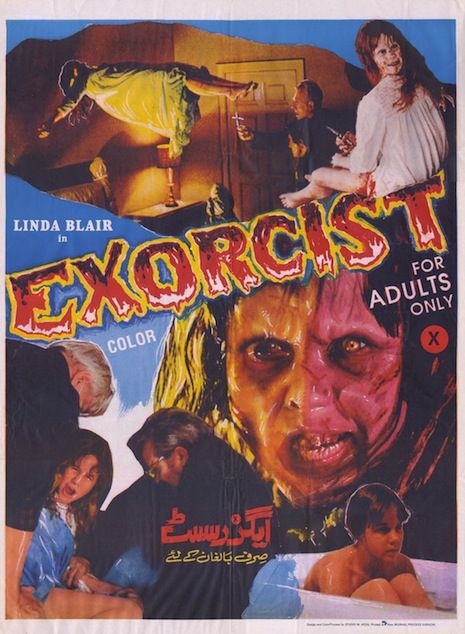
Pakistani poster.
William Friedkin’s horror film, The Exorcist, has been scaring the pants off of moviegoers—as well as making viewers nauseous—since its 1973 release. Even with all of its terrifying and stomach-churning imagery, the picture wouldn’t have been nearly as intense if it weren’t for the hair-raising soundtrack. It’s surprising, then, that director Friedkin hadn’t intended to use the music that ended up as the score for The Exorcist.
Friedkin had first turned to Bernard Herrmann—perhaps the greatest composer in the history of film—to see if he might be up for scoring The Exorcist. To Friedkin’s delight, Hermann was interested, so the director set up a screening. But it did not go well. At all. Recently, Friedkin wrote about the experience:
When he [Herrmann] came out of the screening room he said, “I might be able to help you with this piece of shit, but you’ll have to leave it with me, and I’ll see if I can come up with something.” I had heard he was an abrasive, no-bullshit guy, outspoken to the point of insult. Still, I was stunned at his reaction.
“Leave it with you?”
“Yeah, and when I’m done I’ll mail you a score,” he snapped.
“You’re not interested in my input or ideas?” I asked.
He cracked a weary smile. “Hey kid, how many pictures have you made? I’ve been writing music for forty years.”
“I love your music, but I’m too close to this film to just have you, or anyone else, mail me a score,” I replied.
“Lemme tell ya something,” he said. “You gotta get rid of that first scene, whatever it is in the desert. I don’t understand it and nobody else will either. The picture doesn’t start until you see that kid in her bedroom.”
Now he was losing me. “Out of curiosity,” I said, “what sort of score do you think this needs?”
“There’s a medieval church called St. Giles Cripplegate in the Barbican Center,” he said, “It’s got an amazing organ and beautiful acoustics. That’s where I’d record the score.”
“A church organ for The Exorcist? I don’t think so,” I said. My hostility was now echoing his.
I shook his hand and said, “Thanks for letting me meet an interesting person,” turned, and left. I respect Herrmann, and still love his work, but what good is it if you’re not on the same page?
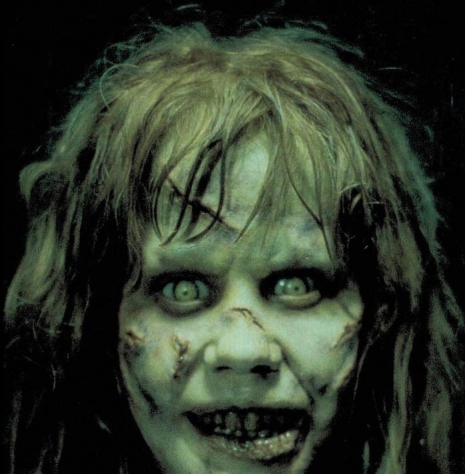
Friedkin then went to another big name in film scoring, Lalo Schifrin. The two came to an agreement, with Friedkin explaining to Schifrin that he wanted chamber music—pieces played by a small group of musicians and similar to what he had been using as his temporary score. Friedkin:
On the first day of recording, he booked what I remember to be about 80 musicians, many of them playing electrified instruments. There were four or five percussionists. This wasn’t going to be chamber music. The first cue he laid down was brassy, percussive, and loud, not at all what we discussed, but the assembled musicians all applauded when he finished.
I took him aside. “Lalo, this isn’t what I asked for.” He seemed surprised.
“What’s wrong?” He asked. “It’s too big,” I said. “It’ll drown out the sound effects and dialogue.”
We went into the control room and he asked the main recording engineer to play back the tracks. They almost blew the speakers out. He walked over to the master dial on the recording panel. “I see the problem” he said, and turned the overall level down. It sounded like 80 guys playing lower. It was completely inappropriate for the film.
I shook my head, “This isn’t going to work.”
When Schifrin refused to change a thing, Friedkin found himself back at square one.
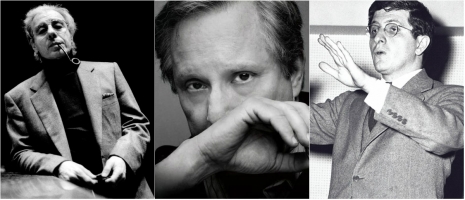
Schifrin, Friedkin, and Herrmann.
With the release date for the movie approaching, Friedkin ended up going with what he had been using as the temporary score (though the music would have to be re-recorded, due to rights issues), plus some additional pieces. The classical works used in The Exorcist—especially those written by the Polish composer, Krzysztof Penderecki—are totally unnerving, filled with “stabbing” violins that recall Bernard Herrmann’s score for Alfred Hitchcock’s Psycho. Still, Friedkin felt there was still something that was missing. He spent three days in the Warner Bros. music library in the hope of finding something resembling a lullaby. Once again, here’s Friedkin:
After listening to and discarding everything after a few bars, I came across a track called “Tubular Bells” by someone named Mike Oldfield on a new label in England, Virgin Records. After the opening motif, which I found haunting, the rest of the track was a kind of demonstration of the sound made by various bells. But, that opening motif, it was perfect.
“Tubular Bells” is taken from Oldfield’s 1973 LP of the same name, which consists of two side-long pieces (this was the era of prog rock, remember). As Friedkin implied, the section of “Tubular Bells” used for the film is taken from the opening minutes of the album. Though it was really only used for one scene in The Exorcist, “Tubular Bells” became known as the film’s theme. In many countries, a single version was released as such.
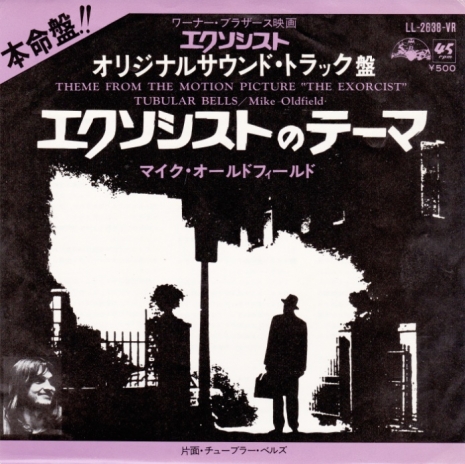
Japanese picture sleeve.
Today, Halloween 2017, the good people at Waxwork Records are dropping their LP reissue of the soundtrack to The Exorcist. It’s been remastered from the original master tapes and pressed on 180 gram colored vinyl, with new liner notes penned by William Friedkin (which we quoted from here). This deluxe edition of the soundtrack also includes a booklet and new artwork by Justin Erickson of Phantom City Creative.
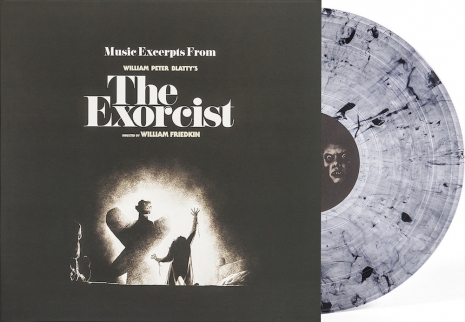
Find out everything you need to know about Waxwork’s reissue of The Exorcist on their website.
Here’s the premiere of “Georgetown”/“Tubular Bells” from the remastered LP:
The soundtrack edit of Oldfield’s composition must have made an impression on John Carpenter, as it brings to mind the theme Carpenter came up with for his 1978 slasher film, Halloween.
We’ll leave you with the scene from The Exorcist in which “Tubular Bells” is heard.

Happy Halloween!
Previously on Dangerous Minds:
Waxwork Records, the leader in beautifully packaged soundtracks on vinyl (plus a DM premiere)